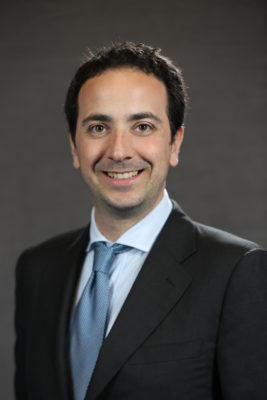Luca Bartolini, MD, a neurologist with Children’s National, was awarded a $50,000/year early career grant administered by the American Epilepsy Society and supported by the Epilepsy Foundation for a study of viral and inflammatory causes of epilepsy.
The research will be conducted at the National Institute of Neurological Diseases and Stroke (NINDS), NIH, where Dr. Bartolini will become an Epilepsy Fellow. His mentors will include Steve Jacobson, PhD, Chief, Viral Immunology Section, as well as William D. Gaillard, MD, Chief, Division of Child Neurology, Epilepsy, Neurophysiology and Critical Care Neurology, Children’s National and Professor of Neurology, George Washington University, and William H. Theodore, MD, Chief, Clinical Epilepsy Section, NINDS.

Luca Bartolini, MD and new Epilepsy Fellow, NINDS/NIH
The group will explore the hypothesis that herpesviruses, including HHV-6B, can trigger an inflammatory cascade in the central nervous system that leads to the development of seizures in children. In a pilot study, they enrolled 115 children with acute seizures and 51 children with acute febrile illness at Children’s National Medical Center, and demonstrated feasibility of detection of HHV-6 in saliva with droplet digital PCR. They also showed cytokine overexpression in saliva from a randomly selected cohort of 32 cases vs. 30 controls. Data on this study will be presented at the 10th International Conference on HHV-6 & 7.
Dr. Bartolini’s goal during the fellowship is to extend this pilot study and collect saliva and blood from children with different types of acute seizures (including febrile seizures, acute seizures in chronic epilepsy and first lifetime seizures) as well as healthy children, to study the frequency of HHV-6 infection by means of ddPCR. They will also study the expression of several cytokines implicated in neuroinflammation and gene expression. They hope to build evidence to support a potential mechanism of epileptogenesis associated with herpesvirus infection that may involve cytokine overexpression in children with seizures.
HHV-6B has been consistently associated with febrile seizures and status epilepticus (Touserkani 2017). In a recent study of 143 children with febrile seizures in Australia, HHV-6 was identified in 12% of simple and 42% of complex febrile seizures (Francis 2016). Another large study of 146 children in the US found that 17% of simple febrile seizures were associated with HHV-6 reactivation (Hall 1994). A large NIH funded study of 200 children with febrile status epilepticus (FSE) found that one third of FSE is caused by HHV-6B infection; 70% of those infections were primary and 30% were reactivations in infants who were unable to control the HHV-6B (Epstein 2012). Many children with febrile status epilepticus go on to develop mesial temporal lobe epilepsy (MTLE), and high levels of HHV-6 DNA is found in the brain resections from these patients (Fotheringham 2007).
